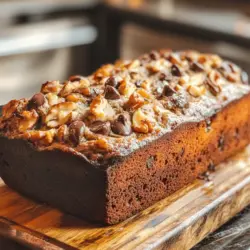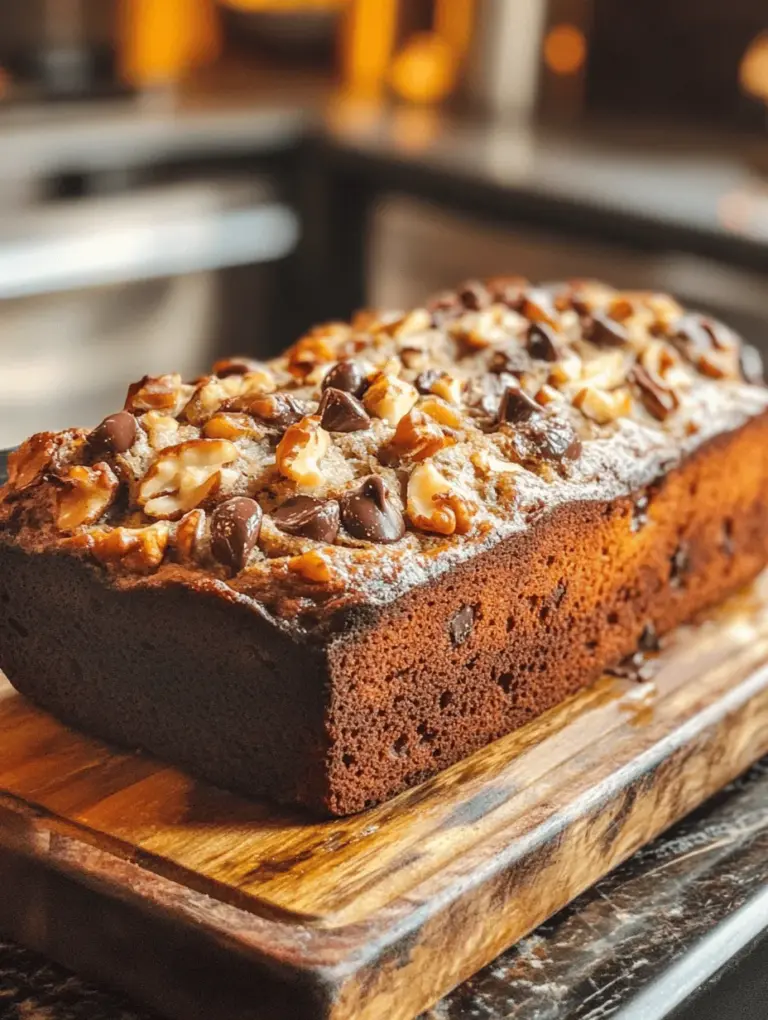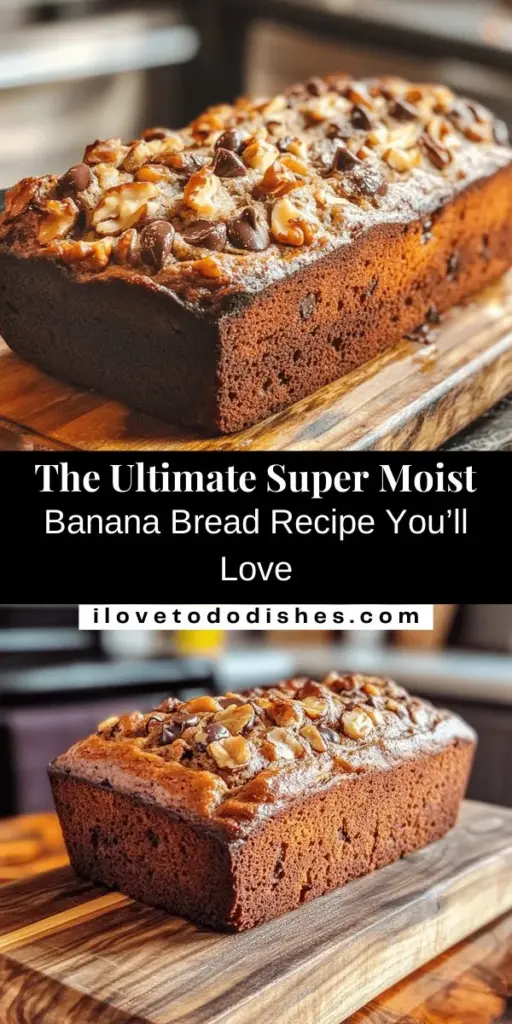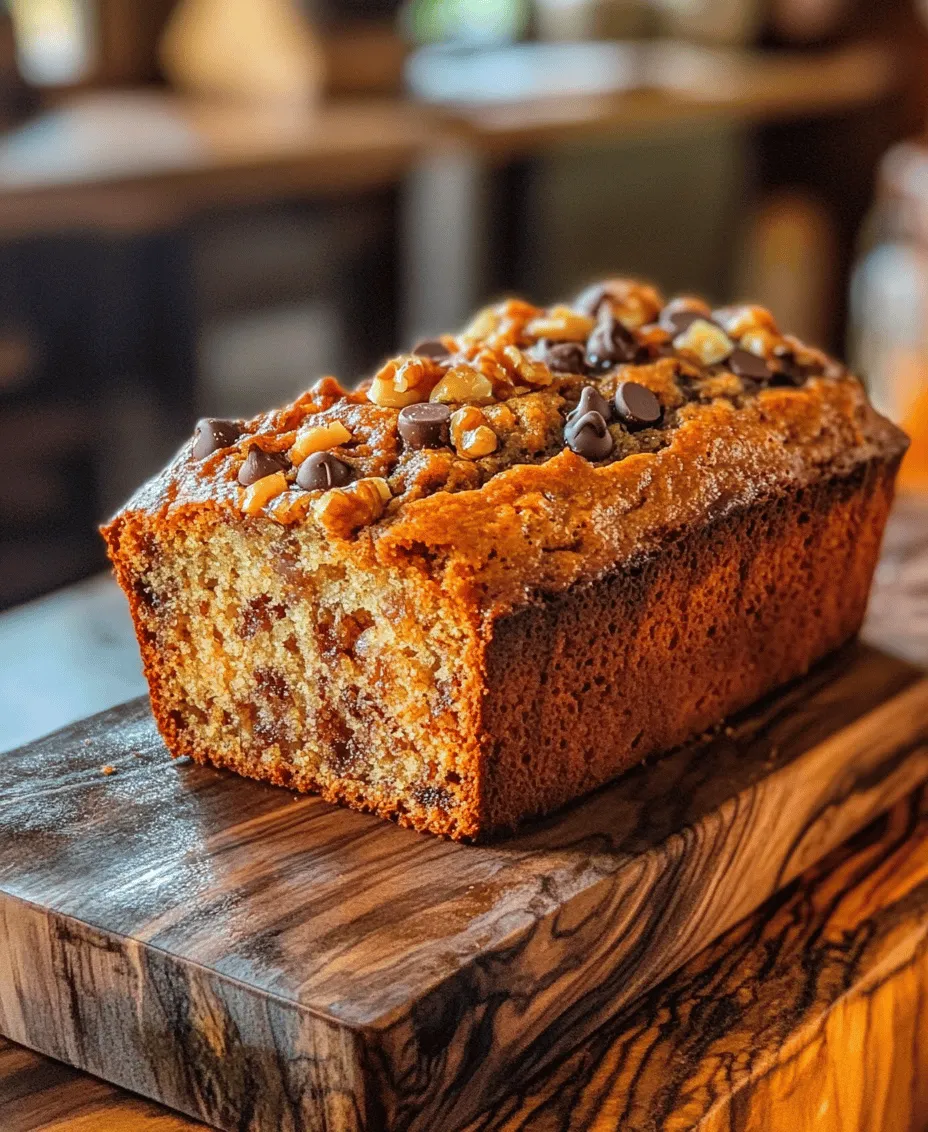Introduction
Banana bread is one of those timeless comfort foods that evoke warm memories of home baking and the irresistible aroma wafting through the kitchen. This beloved classic is not just a recipe; it’s a culinary tradition that has graced family tables for generations. Whether it’s enjoyed as a cozy breakfast, a delightful snack, or a sweet dessert, banana bread has a special place in the hearts of many. What sets this particular recipe apart is its focus on achieving a super moist texture and rich flavor, ensuring that each slice is both satisfying and delectable.
The magic of this banana bread lies in its simplicity and versatility. You can easily customize it to suit your taste preferences or dietary needs by adding optional ingredients. From crunchy walnuts to indulgent chocolate chips, the possibilities are endless, allowing you to make this banana bread uniquely your own. This recipe not only highlights the delightful flavors of ripe bananas but also incorporates other classic ingredients that work harmoniously to enhance the overall experience.
In the following sections, we will delve into the essential ingredients that make this banana bread incredibly moist and flavorful, explore the necessary equipment for baking, and provide you with a step-by-step guide to creating this delicious treat. Get ready to whip up a loaf that will have everyone coming back for seconds!
Understanding the Ingredients
Ripe Bananas
The star of any banana bread recipe is undoubtedly the bananas themselves. For this recipe, using ripe bananas is crucial. As bananas ripen, their starches convert into sugars, resulting in a sweeter flavor and a softer texture. The natural sweetness of ripe bananas not only enhances the taste of the bread but also contributes to its moisture content, ensuring every bite is tender and delicious. Look for bananas that are heavily speckled with brown spots or even fully brown; these are the ideal candidates for your banana bread.
Unsalted Butter
Butter is another key ingredient that adds richness to the banana bread. Using unsalted butter allows you to control the salt content in the recipe, which is important for achieving the right balance of flavors. The fat in the butter also contributes to the moistness of the bread, creating a tender crumb that melts in your mouth. Make sure to let the butter come to room temperature before mixing; this will help it incorporate smoothly with the other ingredients.
Sugars
In this recipe, we will be using both granulated sugar and brown sugar to achieve the perfect sweetness and texture. Granulated sugar provides the necessary sweetness while helping the bread rise, thanks to its ability to create air pockets during creaming with the butter. On the other hand, brown sugar adds a deeper flavor profile and moisture due to its molasses content. This combination of sugars ensures a delightful sweetness without overwhelming the natural flavor of the bananas.
Eggs and Vanilla
Eggs play a vital role in baking, acting as a binding agent that holds the ingredients together while also contributing to the bread’s structure. In addition to their binding properties, eggs add moisture and richness to the banana bread. Vanilla extract is often added for its aromatic qualities, enhancing the overall flavor profile. Together, these ingredients work to elevate the taste of your banana bread, creating a harmonious blend of flavors.
Baking Soda and Salt
Baking soda is the leavening agent in this recipe, which means it helps the bread rise and become light and fluffy. When combined with the acidity of the ripe bananas, baking soda produces carbon dioxide, creating air pockets that result in a tender texture. A pinch of salt is also essential; it balances the sweetness of the sugars and enhances the flavors of the other ingredients, making the banana bread taste even better.
Flour and Cinnamon
All-purpose flour provides the structure needed for the banana bread, ensuring it holds its shape as it rises. The amount of flour used is key to achieving the right consistency; too much flour can lead to a dry loaf, while too little can result in a dense bread. If you choose to include cinnamon in your recipe, it adds a warm, comforting flavor that complements the bananas beautifully. The warm spice not only enhances the taste but also brings a nostalgic aroma that fills the kitchen.
Optional Ingredients
One of the best aspects of banana bread is its adaptability. You can easily customize the recipe to suit your preferences by adding optional ingredients. Chopped nuts, such as walnuts or pecans, provide a delightful crunch and nutty flavor, making each bite more interesting. Chocolate chips are another popular addition, offering a sweet contrast to the bananas and transforming the bread into an indulgent treat. Feel free to experiment with different combinations or even dried fruits like raisins or cranberries for added texture and flavor.
Essential Equipment Needed
Before you start baking your super moist banana bread, it’s important to gather the necessary tools and equipment. Having everything ready will streamline the process and make your baking experience more enjoyable. Here’s what you’ll need:
– Mixing Bowls: A set of mixing bowls in various sizes will allow you to combine and mix your ingredients easily.
– Fork or Potato Masher: Use a fork or a potato masher to mash the ripe bananas until they are smooth; this will help distribute their flavor throughout the batter.
– Measuring Cups and Spoons: Accurate measurements are crucial in baking, so ensure you have a reliable set of measuring cups and spoons to get the ratios just right.
– Whisk: A whisk will help you mix dry ingredients together and also combine wet ingredients smoothly.
– Rubber Spatula: A rubber spatula is perfect for scraping down the sides of the mixing bowl and folding in ingredients without deflating the batter.
– 9×5-Inch Loaf Pan: The right size loaf pan is essential for even baking. A standard 9×5-inch loaf pan works perfectly for this recipe.
– Oven: Preheat your oven to the specified temperature to ensure even cooking.
– Wire Rack for Cooling: Once the banana bread is baked, transferring it to a wire rack allows it to cool evenly, preventing sogginess on the bottom.
Step-by-Step Instructions for Super Moist Banana Bread
Now that you have a good understanding of the ingredients and tools needed, let’s dive into the step-by-step instructions for making your super moist banana bread. The first steps are crucial in setting the foundation for a delicious loaf, so follow along carefully.
Preparation
1. Preheat the Oven: Start by preheating your oven to 350°F (175°C). This ensures that your banana bread will bake evenly and rise properly.
2. Prepare the Loaf Pan: While the oven is heating, prepare your loaf pan. Grease the inside of the 9×5-inch loaf pan with butter or non-stick spray to prevent the banana bread from sticking. You can also line the bottom with parchment paper for extra insurance.
3. Mash the Bananas: In a mixing bowl, take your ripe bananas and mash them using a fork or potato masher until they are mostly smooth with some chunks remaining for texture. Aim for about 1 to 1 ½ cups of mashed bananas, which is typically around 3 to 4 medium-sized ripe bananas.
By following these initial steps with care, you’ll lay the groundwork for creating a banana bread that is moist, flavorful, and sure to become a favorite in your household. Stay tuned for the subsequent steps where we will mix the ingredients, pour the batter into the loaf pan, and bake to perfection!
Mixing the Wet Ingredients
To create the foundation of your super moist banana bread, start by mashing the bananas. Use ripe bananas, as they provide the sweetness and moisture that make the bread so delightful. Place about three medium-sized ripe bananas in a large mixing bowl. Using a fork or a potato masher, mash them until they are mostly smooth with a few small lumps remaining. This adds texture to the final product and prevents it from becoming gummy.
Next, melt half a cup of unsalted butter. Allow it to cool slightly before adding it to the mashed bananas to avoid cooking the bananas. Incorporate the melted butter into the mashed bananas, mixing well to ensure a homogeneous mixture. Now, add three-quarters cup of granulated sugar and a quarter cup of brown sugar. The combination of both sugars enhances the flavor and moisture of the banana bread, resulting in a richer taste. Stir these ingredients together until they are well combined and creamy.
Incorporating the Egg and Vanilla
Once your wet ingredients are mixed, it’s time to add an egg and a teaspoon of pure vanilla extract. The egg provides stability and helps the bread rise, while the vanilla adds a lovely aroma and depth of flavor. Crack the egg into the bowl and beat it lightly with a fork before folding it into the banana mixture. Mixing in the egg thoroughly ensures that the batter has a uniform texture, which is essential for even baking.
After incorporating the egg, add the vanilla extract and mix again until everything is well blended. The result should be a smooth and creamy banana mixture that smells incredible.
Combining Dry Ingredients
While the wet ingredients are coming together beautifully, it’s crucial to work on the dry components separately. In a medium bowl, whisk together one and a half cups of all-purpose flour, one teaspoon of baking soda, and a pinch of salt. This step is essential as it ensures that the baking soda and salt are evenly distributed throughout the flour, which helps the bread rise evenly and prevents any bitter bites from concentrated salt or baking soda.
Whisk the dry ingredients until they are fully combined and free of lumps. This simple technique will enhance the overall texture of your banana bread.
Bringing It All Together
With both wet and dry ingredients prepared, it’s time to unite them. Gently fold the dry ingredients into the wet mixture using a spatula or a wooden spoon. Be cautious not to overmix; the goal is to combine the ingredients just until you no longer see dry flour. Overmixing can lead to dense banana bread, which is not what you want. A few lumps in the batter are perfectly fine; they will bake out during the cooking process.
This folding technique ensures that you maintain the airiness of the batter, which contributes to the moist, tender crumb of the final loaf.
Adding Optional Ingredients
To elevate your banana bread even further, consider adding optional ingredients. Chopped walnuts or pecans can provide a delightful crunch and a nutty flavor. If you prefer chocolate, a half-cup of chocolate chips can be folded in for a sweet twist. When incorporating these extras, make sure to gently fold them into the batter, being careful not to overmix.
If you’re looking for a different flavor profile, you might consider adding a teaspoon of cinnamon or nutmeg for a warm, spiced banana bread. Alternatively, dried fruits like raisins or cranberries can add a chewy texture and additional sweetness.
Baking
Preheat your oven to 350°F (175°C) before you start mixing your ingredients. This ensures that your banana bread will bake evenly and rise properly. Grease a standard 9×5-inch loaf pan or line it with parchment paper for easy removal after baking. Pour the batter into the prepared pan, spreading it evenly.
Bake the banana bread for 60-70 minutes. To check for doneness, insert a toothpick into the center of the loaf. If it comes out clean or with just a few crumbs clinging to it, your banana bread is ready to come out of the oven. If not, give it an additional 5-10 minutes and check again.
Cooling and Slicing
Once baked, remove the banana bread from the oven and allow it to cool in the pan for about 10-15 minutes. This cooling period is crucial as it allows the loaf to set and makes it easier to remove from the pan without falling apart. After it has cooled slightly, turn it out onto a wire rack to cool completely.
Letting the banana bread cool completely before slicing is vital for achieving the best texture. When still warm, the bread can be overly moist and crumbly. Once cool, slice the banana bread into even pieces and enjoy the results of your hard work!
Common Mistakes to Avoid
Making banana bread may seem straightforward, but a few common pitfalls can lead to disappointing results. Here are some mistakes to avoid:
1. Using under-ripe bananas: For the best flavor and moisture, always use ripe bananas. They should be heavily speckled with brown spots, indicating peak ripeness.
2. Overmixing the batter: As mentioned before, overmixing can result in dense, tough bread. Mix just until combined for a light, fluffy texture.
3. Not checking the oven temperature: Oven temperatures can vary. Use an oven thermometer to ensure your oven is at the correct temperature to avoid undercooked or burnt bread.
4. Cooling the bread improperly: Allow the bread to cool in the pan for the right amount of time before transferring it to a wire rack. This helps maintain its structure and prevents sogginess.
Nutritional Benefits of Banana Bread
Banana bread isn’t just delicious; it also offers some nutritional benefits thanks to its wholesome ingredients.
– Bananas: These fruits are rich in potassium, which is essential for heart health, and they provide vitamins C and B6, along with dietary fiber, which aids digestion.
– Nuts: When you add nuts to your banana bread, you introduce healthy fats and protein, which help keep you satiated. Nuts are also a good source of omega-3 fatty acids and antioxidants.
– Moderation in Sugars: The sugars used in your banana bread can be adjusted for a healthier version. You can reduce the amount of sugar or substitute with natural sweeteners like honey or maple syrup, keeping in mind that these alternatives may affect the final texture and taste.
Variations of Banana Bread
Banana bread is a versatile recipe that can be easily adapted to suit various dietary needs and preferences. Here are some creative twists you can try:
– Nut-Free Version: For those with nut allergies, simply omit the nuts or substitute them with seeds like sunflower or pumpkin seeds for added crunch and nutrition.
– Gluten-Free Option: To make a gluten-free banana bread, use a gluten-free all-purpose flour blend. Ensure the blend you choose contains a binding agent, such as xanthan gum, to help the bread rise.
– Add-Ins: Explore various flavors by adding dried fruits like cranberries or apricots, or spices such as cinnamon, nutmeg, or even a hint of ginger for an aromatic touch.
Conclusion
Baking super moist banana bread brings joy and comfort to any kitchen. With its delectable aroma and rich flavor, banana bread is not only a treat for yourself but also a wonderful gift to share with friends and family. The beauty of this recipe lies in its versatility, allowing you to personalize it according to your preferences and dietary needs.
Whether you enjoy it warm with a pat of butter, toasted with a sprinkle of cinnamon, or as a quick snack on the go, this banana bread is sure to become a favorite. So roll up your sleeves, gather your ingredients, and dive into the delightful world of banana bread baking. The satisfaction of creating something from scratch is unparalleled, and the taste of freshly baked banana bread is worth every moment spent in the kitchen. Enjoy experimenting with your variations and savor the simplicity of this beloved homemade classic.



